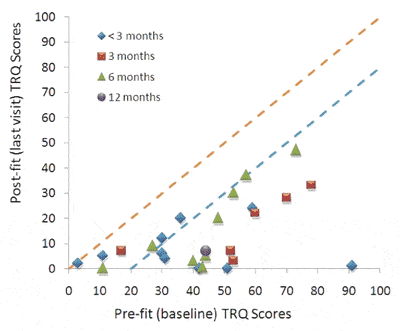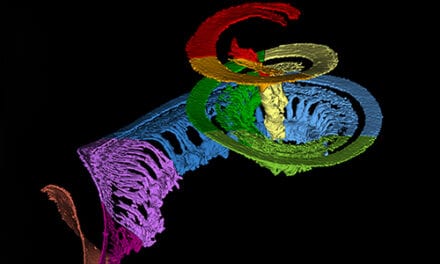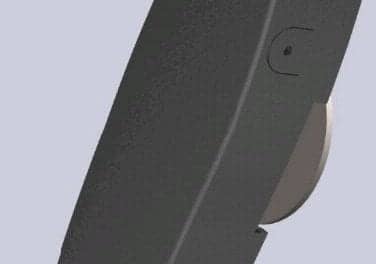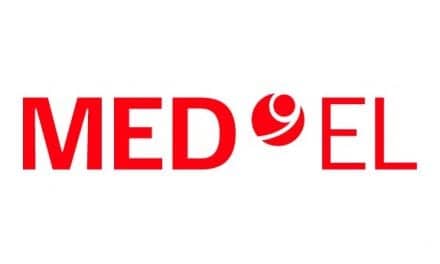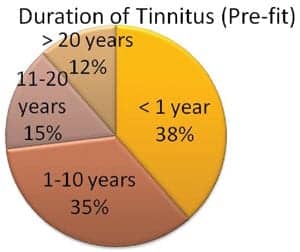
We’ve come a long way, baby! Dr Martin Cooper, inventor of the cellular phone, poses with an early model. Source: Rico Shen.
As hearing instruments advance technologically, they require more power in smaller packages. At the same time, global concerns demand environmentally friendly products. To successfully meet these demands, button cell battery manufacturers are using methodical research and development to produce reliable power supplies.
The first generation of cell phones helped to launch a new era of communications, despite being bulky, expensive, and of limited use. Now, at least four generations into the technology, those early devices have become comic fodder for some, ancient relics for others. That same evolution has taken place with hearing instruments.
“It’s absolutely night and day compared to what the technology was just 10 years ago,” says Bill Flanagan, national sales manager for Varta Microbattery Inc, White Plains, NY, of both cell phone and hearing assistance technologies. Today’s hearing devices feature wireless capabilities, noise canceling, multiple listening programs, and other advanced processing tools within much smaller designs than first-generation hearing aids.
“Today’s instruments have numerous circuits and require greater and sustained voltage in order to operate the numerous features and benefits they offer, so having a reliable battery that delivers a constant high voltage is really the objective today,” Flanagan says. Manufacturers’ first concern is not necessarily how long a battery will last, but what voltage it can reliably deliver.
After the question of reliability, other factors will play a role in guiding the selection of hearing aid batteries by manufacturers, audiologists, and end users. Today, many of these have an environmental component, which is driving the demand for both mercury-free and rechargeable products.
Microbattery manufacturers are striving to meet these demands with reliable products, since the most environmentally friendly battery is useless if it does not work. Some companies, therefore, take a very methodical approach to development, avoiding a race to market and instead focusing on the endurance and quality of the product.
RELIABLE RESEARCH, RELIABLE BATTERIES
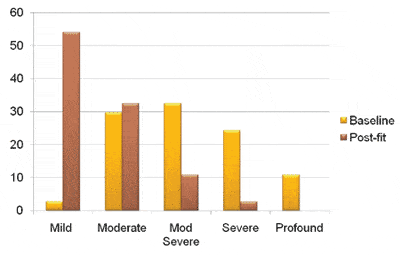
Frank Wang, general manager of ZeniPower Battery Co, Ltd, China
In general, microbattery manufacturers report methodical research and development processes that range from 6 months to 3 years depending on the company, the battery technology, and the scope of the project (eg, the launch of a new battery versus improving a feature on an existing product). Many companies are already at work on batteries they expect to launch in 2013 and 2014.
Some companies, like Madison, Wis-based Rayovac, start the research and development process with a new design concept.
“This could be a design change that will improve some aspect of the product’s performance, such as improving service life or leakage resistance,” says Ann Rule, marketing manager for hearing aids at Rayovac. “It could be the addition of a design feature or function in response to customer feedback; or it could be replacement of a material that will cut the cost of making the battery without compromising performance.”
Small runs are then conducted on the company’s pilot line, where, if the product is viable, it is further tested in small plant trials, eventually advancing to limited plan runs that gradually increase in production volume. “At each stage of this process, a data review is conducted to determine if we can go forward with the concept,” Rule says.
This type of methodical approach to development helps to ensure quality and performance, eliminating surprises and safekeeping reputation.
Varta employs its own meticulous approach to development so that when the company does bring a product to market, “We are 100% confident the product will perform as stated and there will be no issues,” Flanagan says.
Each step of development frequently requires comprehensive testing, a process undertaken in some form by all manufacturers.
“Testing takes place on many more levels than imagined,” says Henry Kessler of Sy Kessler Sales Inc, Dallas, North American headquarters for Renata Batteries.
At China-based ZeniPower Battery Co, Ltd (Zhuhai, Guang Dong), testing is rigorous as well, covering discharge voltage (working voltage) at different drains; discharge hours (battery life) at different drains; mechanical measurement of the battery dimension in these conditions; and safety tests on abuse of the batteries, short circuit, heat, overdischarge, and more. This battery of tests is completed in standard, dry, and wet environments, then repeated after a simulated aging (12 weeks in a 1,400°F oven). If the device passes, it is then field tested with a small quantity of batteries and selected customers for at least 3 months.
The tests, undertaken by many manufacturers, are designed to identify product flaws (or even feasibility) before they get to market. If they reveal little improvement over existing products, they may go back to the drawing board. Even when a product is “flawless,” most companies employ a process of continuous improvement after initial production. “Once in production, the testing and analysis continue while following a rigorous quality management program,” Rule says.
MERCURY-FREE
A commitment to continuous improvement means that whatever batteries are available today will eventually make way for advanced technologies. Today, however, the big buzz is mercury-free.
St Louis-based Energizer with its Zero Mercury Hearing Aid Battery and Rayovac with its Mercury Free ProLine Battery were the first two companies to deliver mercury-free button cells.
“The mercury-free batteries are the new trend for hearing aid batteries today as there are a few US states that will ban the standard hearing aid batteries with mercury beginning in July 2011,” Wang says, noting this is not occurring elsewhere on the globe just yet.
The push, however, may be premature. Some early adopters have reported problems with reliability and voltage consistency. “I personally think the technology is not quite ready yet,” Wang says, referring to those mercury-free batteries on the market that he believes have not performed as well as standard products.
“Hearing aid producers may be forced to limit features or live with shorter battery life, but it remains too early to know for sure,” Kessler suggests.
Although performance concerns have caused the industry to take pause, most expect the mercury-free ban to extend throughout the country because “environmentally, it’s a good thing to do,” Flanagan says.
Years ago, the first hearing aid batteries made were silver-oxide. But then the whole industry changed to mercuric-oxide batteries, which had something like a thousand times more mercury in them than the current hearing aid battery has. When that was banned, the industry went to zinc-air batteries, which still contain about 25 milligrams of mercury—a substantial reduction from mercury-oxide, in which half the battery was mercury.
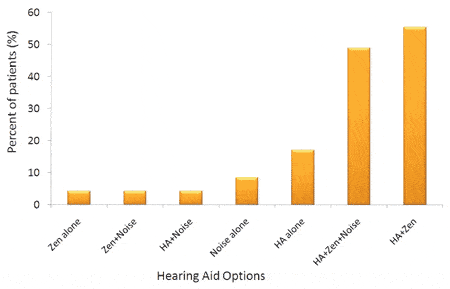
ZeniPower’s Zinc Air Hearing Aid Batteries are available in a range of sizes, from A675 to A10, including cochlear.
As to why there’s any mercury at all in zinc-air batteries, it’s a matter of chemistry. Simply put, mercury helps control unwanted gassing reactions that happen during discharge, allowing manufacturers to make a more stable battery that doesn’t leak and provides better performance.
But mercury’s days in hearing aid batteries are definitely numbered. What started with Connecticut and Maine has grown tremendously. According to the Environmental Protection Agency, 33 states have passed laws, have active bills being considered, or have established regulations or ordinances with the goal of reducing mercury emissions to air, land, and water.
Wang believes more research and development will produce a stronger mercury-free product. ZeniPower expects to introduce its mercury-free battery sometime in 2011. Varta, too, is planning to launch its foray into the mercury-free battery market, after careful development, in time for the July 1, 2011, deadline. Both companies want their mercury-free batteries to rival the performance of their standard offerings.
Rayovac, which launched its Mercury Free ProLine battery last year, is now getting ready to introduce this fall its second-generation mercury-free battery, featuring more power, higher voltage, and a lifespan equal to that of the company’s standard product.
“They also meet other quality criteria, such as being resistant to leakage, rust, corrosion, and swelling,” Rule adds.
ALL CHARGED UP
As the hearing health care industry keeps its eye on mercury-free developments, battery manufacturers are looking one step ahead to rechargeable products, which many believe is the way of the future.
“People will use their hearing aids just like their cell phones—charge them at night and use them during the day. They can avoid the trouble of buying and changing these tiny batteries, especially senior citizens. I believe this will be the future of the hearing aid industry in the long run, and that it will be mainstream in 5 to 10 years,” Wang says.
Rechargeability has been a big focus at Varta, and the company’s latest product rounds out its offerings in this arena. “We now offer a complete solution of rechargeable options for all four types of batteries, along with charger solutions that include a pocket charger and a pen charger,” Flanagan says.
The rechargeable technology uses nickel-metal hydride chemistry (which is mercury-free) rather than zinc-air. “There are no tabs for battery activations, and it’s a sealed system,” Flanagan says.
Life expectancy varies with the hearing instrument and its settings but generally falls between 12 and 18 months. “You can estimate that a rechargeable battery replaces on average about 57 primary disposal batteries under normal use and circumstances, so there’s really an environmental benefit to using rechargeable technology,” Flanagan says. Over its lifetime, a rechargeable battery will also save the user money, though the up-front cost is more than that for a traditional battery.
“It’s not easy to make a rechargeable battery that small, and it requires a certain level of R&D expertise,” Flanagan says, explaining the capital cost. Yet, as environmental concerns continue to rise and technology continues to advance, more manufacturers can be expected to tackle the challenge.
SOUNDING OUT THE FUTURE
“My crystal ball says sales of rechargeable hearing devices will really take off, as the hearing aid is partially repositioned to a device most everybody could benefit from,” Kessler says.
Some hearing instrument manufacturers are beginning to explore more direct lines to the end user, and hearing aids and other supplies can now be found online or even in mall kiosks.
“I don’t know where the trend is leading, but [hearing instruments] seem to be moving into more of a retail-accessible direction rather than strictly being a professionally provided product through a highly trained and educated audiologist,” Flanagan says.
Thus far, a number of battery manufacturers have product lines that target the audiology professional only, such as Rayovac’s ProLine, Renata’s Maratone Plus, and Varta’s Power One.
“We intentionally brought Power One to market almost 9 years ago with the intention of it being a professionally focused brand,” Flanagan says.
The approach allows the audiologist to better maintain a relationship with the patient. “If the patient is really satisfied with the battery and the only place they can get it is through their audiologist, it really allows the audiologist to provide additional services,” Flanagan says.
Reliable products can, therefore, help an audiologist build a business; unreliable products can lead to unhappy customers, lost revenue, and bad word-of-mouth for the audiologist, the device manufacturer, and the battery maker. And with today’s cell phones, that communication can occur rapidly and take a few product generations to mitigate.
Renee Diiulio is a contributing writer for Hearing Review Products. She can be reached via Editor Will Campbell at [email protected].
Sound Batteries for the Sound Professional
Hearing instrument batteries may be sold directly to the consumer or through an audiologist only, depending on the product. Many manufacturers offer both. Hearing Review Products takes a quick look at the professional product lines associated with our battery “sound” experts:
Energizer
St Louis
Energizer offers innovative packaging and a full line of mercury-free hearing aid batteries in all sizes: 10, 13, 312, and 675.
iCellTech
Seoul, Korea
iCellTech is one of the fastest growing hearing aid battery brands in the world with an annual production capacity of 50 million batteries (in sizes 10, 13, 312 and 675, and 675CI) distributed to more than 40 countries.
Rayovac
Madison, Wis
Rayovac offers three battery lines for the professional customer:
- Cochlear Plus, designed for cochlear implants;
- ProLine Advanced, a premium zinc-air hearing aid battery; and
- ProLine Mercury Free, Rayovac’s entry into this arena of hearing aid batteries.
Renata/Sy Kessler Sales Inc
Dallas
Renata’s Maratone Plus zinc-air batteries are available in four sizes, each offering a nominal voltage of 1.4.
Varta Microbattery Inc
White Plains, NY
Varta’s Power One line of batteries includes:
- A complete line of rechargeable batteries and chargers;
- A complete line of zinc-air batteries;
- The Power One Implant Plus, a zinc-air battery designed for implants; and
- The Power One Accu Plus, a rechargeable battery with a colored surface coating using nanotechnology to provide protection against corrosion.
ZeniPower Battery Co, Ltd
Zhuhai, Guang Dong, China
ZeniPower’s Zinc Air Hearing Aid Batteries are available in a range of sizes, from A675 to A10, including cochlear. In 2008, the company began investing in rechargeable lithium ion battery technology and aims to produce a line of batteries in this arena as well.


